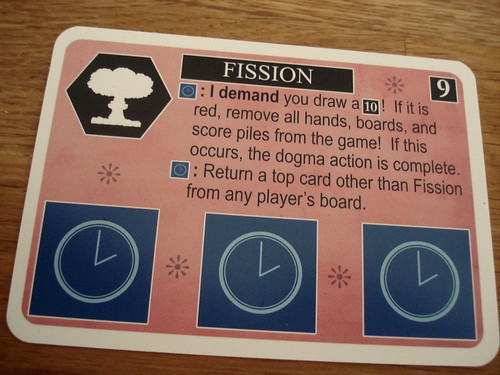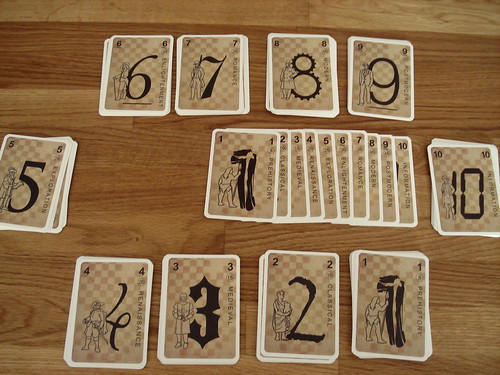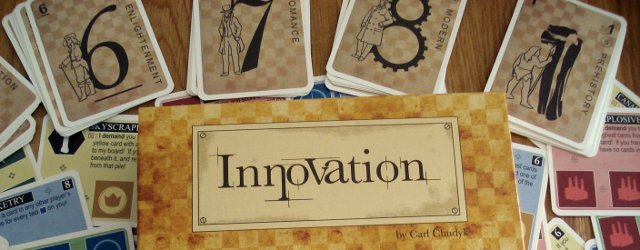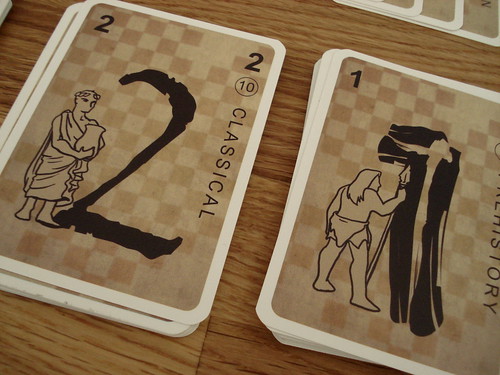| Strategy | Luck |
|---|---|
| Interaction | Components & Design |
| Complexity | Score |
Games where you develop a civilisation are not a rare commodity. There’s dozens of games with that theme, employing a large variety of mechanics. There is a tendency for them to be humongous board games with hundreds of pieces – most of them, to their great detriment, don’t use meeples – being pushed around a map conquering, marauding and possibly pillaging; games with a big “tech tree” that tells players they need to build an igloo before they can develop a writing system and subsequently train lion-mounted archers. (Just to clarify: I don’t dislike these games, quite on the contrary, but some of the connections they make in their research trees really make me scratch my head.) There is exceptions of course: games that use the same setting, but with wildly different mechanics; without a game board, without a research tree you’re still supposed to build up your civilisation from banging rocks together to building space stations.
One such game is Innovation, a card game that gained a bit of popularity last year with easy rules and clever interaction mechanics but still flew completely under the radar of many people. Before I tell you more about the game mechanics, let me get the elephant out of the room: the first thing you will realise about Innovation when you open the box is that it’s not a pretty game. I feel I’m allowed to point that out, because it doesn’t look like it does by accident. Someone took a conscious decision to design the front of the cards in garish colours with big symbols in equally garish but not-at-all matching colours on them. How do I know that was a conscious decision? The box and the back of the cards do have a very nice look to them, it’s only the front of the cards that don’t. However, there is undeniably good reasons for that design choice: if your eyesight is still good and fresh you can tell all important information about a card from the other end of the table, an ability that can’t be rated high enough in Innovation.

So, these cards are the core of the game – easy to say since there is nothing else in the game. Every card represents one big innovation in human history, going from the very beginning with ideas like Domestication or Masonry to the very end where you have Globalization and AI. Cards belong in one of ten eras of civilisation, from prehistory through the renaissance up into the information age and are separated into stacks according to that. The front of each card, as mentioned above, displays quite a bit of relevant information: along the lower and left edges are symbols that have a rough relation to the concept of the innovation: towers for ancient warfare, factories for industrialisation and so on; what the symbols represent is not as important as how they make players interact. More on that in a bit. The other important piece of information is the cards’ dogma text: the dogma is something this card allows you to do when you invoke it, or allows you to force others into.
So, with all the information in place, what do you do? You start the game with two cards from prehistory in your hand and take two actions on your turn (or one action twice). Three of the possible actions are fast and straightforward:
- you can meld a card from your hand, meaning you just play it on the table in front of you. If you already have a card of the same colour, the new one covers it, hiding the old card’s dogma and symbols – for now. Since there is five colours, you can have at most five stacks of cards.
- you can draw a card to your hand. You always draw cards from the highest era that is visible in front of you. If you have card from the renaissance visible, renaissance is what you will draw. If the stack you would draw from is empty, you draw from the next higher stack instead – especially in four players, this is the most common way to advance to the next age.
- you can achieve, meaning you take the next available achievement card. There is one for each age, and in order to you have it you need to have a top card of that age or higher and to have five points per age of the achievement in your score pile – where you can only get them using dogma effects. Achievements are one way to win the game: as soon as a player has the required number of achievements (six with two players, four with four) he wins the game.

The final option you can pick for an action is to invoke the dogma of any of your top cards. This is important, many people get confused the first time they play: the dogma does nothing when you meld the card, it only has an effect when you subsequently invoke it. Dogma effects are the real juice of Innovation. Every card – and there are many of them – has a unique dogma effect. Most dogmas are easy, allowing you to draw a card from a higher era, put a card in your score pile, meld two cards; things like that. Some dogmas are more complex, asking you to draw and reveal cards and do something with them based on their colour or symbol, or asking you to do something with any number of cards and then have an effect based on that number. Once a dogma is invoked, every effect is mandatory unless it includes the words “you may”.
Invoking a dogma effect is also where you interact with other players, and this is where a lot of strategy enters Innovation and it goes beyond a simple “I build an engine with my cards and watch it run” game: every dogma also has a symbol associated with it. When you invoke a dogma, every player that has as many or more of that symbol showing on his cards as you do gets to execute that dogma before you. This is, usually, to their benefit and thus gives you a reward in form of a free card draw. With most of the effects being mandatory, however, you can also use this to very sneaky effects: forcing another player to meld all cards from his hand before he has a chance to invoke his own dogma to score cards from his hand? And getting a free card on top of that? Yes, please.
The other interaction with dogmas is “I demand” effects. Here, you force every player with less of the relevant symbol to perform an action he won’t be all that happy about: returning cards from his hand, moving cards from his score pile to your score pile. That kind of fun.

Now with the high value of having the right symbols, you might be tempted not to play new cards in order to not cover the symbols you need for your defence. That would make for a very slow game with nothing moving, so this is where the final innovative idea of Innovation comes in: splaying. Some dogma actions allow you to splay a colour of your cards left, right or up , meaning you open one stack in the given direction, revealing some of the symbols of the cards below again. The cards at the bottom of the stack don’t become useless and there is no need to inhibit your own progress.
With the amount of cards available, their unique dogma effects and different sets of symbols, it’s safe to say you will never encounter the same situation in the game twice. No card is inherently more valuable than another, everything depends on the other cards in play. Nevertheless, there is cards you will want to be protected from, and knowing when these cards may show up is important in advanced play: knowing which symbols to collect can decide the game.
Besides one player gaining enough achievements, the game also ends when someone would draw a card from age eleven – which doesn’t exist – because the stack for age ten is empty. If that happens, achievements count for nothing and the player with the highest score wins. Finally, the higher ages have some cards that end the game with various victory conditions. When these cards start showing up, nothing you have is a guaranteed victory any more. If you wanted to win with achievements you’d better be done at this time. If someone else is close to winning, these cards offer a quick reversal of fortunes. While this keeps the game tense until the end, it also reveals the problem it has: you can play well the whole game, if someone else draws the right card at the right time, he can steal your victory, no matter how badly he played before.

With two players, the problem of luck only comes up occasionally and the game is nicely tactical, with a rapidly changing game situation to keep you on your toes. Managing your visible symbols to defend against your opponent is difficult but possible, you usually have a chance to react to what they do. With four players, on the other hand, there is not much strategy left and luck reigns supreme: between two turns, three opponents get to force actions on you and demand you do things, planning for the next turn becomes all but impossible and your actions are controlled by which cards you have. Collecting symbols to defend yourself is very hard because there is not enough cards in any given era for everyone to build an effective defence, and the main route of advancing to another age is through exhausting the stack of the previous one. That amount of luck is okay in a game like Fluxx, but here it simply doesn’t match up to the perceived tactical options. There are, however, rules to play in teams that reduce the luck-dependence in four players, but they don’t eliminate the problem.
Nevertheless, the concept of Innovation is – I had to use the word at some point – innovative and in two players it’s a game with a lot of replayability and meaningful decision. With more players, the entertainment is still there, but you should be aware that Innovation becomes mostly a game of luck.
* The scores for luck and strategy are for playing in two players. In four players, it’s about seven points of luck and four points of strategy.











